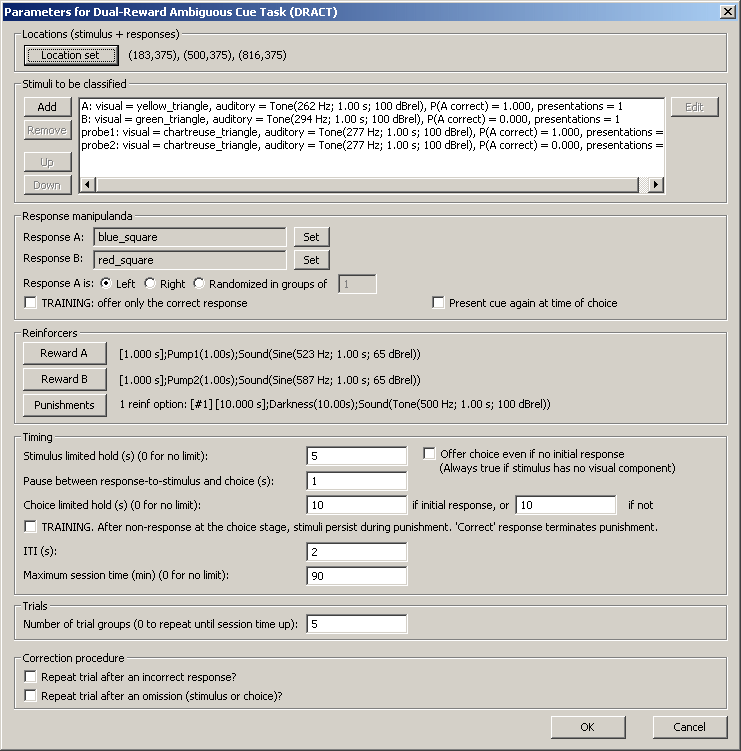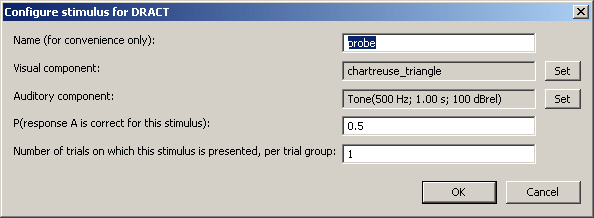Summary
| • | A stimulus is presented as a cue (and must be responded to, unless it's an auditory-only stimulus). |
| • | A choice is presented between manipulanda A and B. The stimulus is also re-presented at the same time (optionally). |
| • | Some cue stimuli signal that A is correct: responding to manipulandum A will deliver reward A. |
| • | Some cue stimuli signal that B is correct: responding to manipulandum B will deliver a different reward B. |
| • | Some cue stimuli may be intermediate, and signal that either A or B is correct, probabilistically. |
| • | Failure to respond, or an incorrect response, leads to "punishment" (e.g. a timeout). |
About the task
This task is currently RESTRICTED to specified laboratories.
Most distributions of MonkeyCantab do not provide it, will refuse requests to add this task, and will not load the parts of configurations that incorporate this task.
Based broadly on Hales et al. (2016), PMID 27023442.
Trial structure
| • | For a given trial, a stimulus is selected. That stimulus may have a visual component, and may have an auditory component. It is also associated with a probabilities that response A is correct, P(A correct), and correspondingly P(B correct) = 1 - P(A correct). |
| • | The stimulus is presented. If it has a visual component, it must typically be responded to (and failure terminates the trial as an omission), though there is an option not to require this response. If it's an auditory-only stimulus, responding is impossible, so it's just played. |
| • | After the stimulus is chosen (or vanishes spontaneously for auditory-only stimuli), there is a short pause. |
| • | A choice is then presented between manipulanda (responses) A or B. The stimulus is also re-presented at the same time. |
| • | If the subject responds to the correct stimulus, it wins the corresponding reward. If it responds incorrectly, or fails to respond, it is punished (e.g. with a timeout). (There are some extra options for training.) |
| • | After reward or punishment is complete, there is an intertrial interval (ITI) before the next trial starts. |
Configuring the task

The options are as follows:
LOCATION SET
Pick a group of three on-screen locations. The first is for response A; the second is for the stimulus; the third is for response B.
STIMULI
Add and configure your stimuli here. When you edit one, you get this dialogue:

| • | Name. Every stimulus has a name; this is just for the operator's convenience. Names must be unique within an instance of the task. |
| • | Visual component. The stimulus can have a visual component. See Visual Stimuli. |
| • | Auditory component. The stimulus can have an auditory component. See Sounds. (You must specify either an auditory or a visual component, or both. If there is no visual component, the subject will not be required to respond to the stimulus in the initial presentation phase.) Note that sounds will be "looped" (repeated continually) to satisfy the timing requirements of the task (see below), so sound durations that you configure here are of less relevance, as long as it's not zero. |
| • | P(A correct). Choose the probability that, when this stimulus is presented, response A is the correct one. (The probability of B being correct will be 1 minus this.) |
| • | Number of trials. The number of trials that will use this stimulus, in a trial group. See below. |
Trial groups. Suppose you design three stimuli, and call them X, Y, and Z. You specify that X should be used 3 times per group, Y should be used 1 time per group, and Z should be used 3 times per group. The task will proceed as follows: it will create a group of stimuli {X, X, X, Y, Z, Z, Z}; it will shuffle this group; and it will use them on each consecutive trial (drawing without replacement). That is a "trial group". The task might end then, or you might choose to present several trial groups per session.
Note on probe stimuli. Depending on the degree of randomness, you can handle this in several ways. If you want true randomness, and probe trials being a minority, you could do this:
| • | define stimulus X: A always correct, 10 trials per group |
| • | define stimulus Z: B always correct, 10 trials per group |
| • | define stimulus Y: probe; perceptually intermediate between X and Z; 2 trials per group; P(A correct) = 0.5 |
However, because P(A correct) is implemented stochastically, you might find that your probe trial was treated as "A correct" on 2 out of 2 trials in a group.
To ensure probe counterbalancing, you could do this instead:
| • | define stimulus X: A always correct, 10 trials per group |
| • | define stimulus Z: B always correct, 10 trials per group |
| • | define stimulus Y1: probe; perceptually intermediate between X and Z; 1 trial per group; P(A correct) = 1 |
| • | define stimulus Y2: probe; perceptually identical to Y1; 1 trial per group; P(A correct) = 0 |
That will give you a guarantee that your probe will be "A correct" on 50% of trials within each group (not just on average).
MANIPULANDA
| • | Response A. The visual stimulus used for response A. |
| • | Response B. The visual stimulus used for response B. |
| • | Response A side. You can set response A to be always on the left, always on the right, or randomized. If you choose randomized, you can choose the group size, or draw-without-replacement multiplier. For example, if you choose "1", you might get patterns like {L, R}, {L, R}, {R, L}, {L, R}. If you choose "3", you might get patterns like {L, L, L, R, R, R}, {L, R, R, L, R, L}, {R, R, L, R, L, L}, and so on. |
| • | TRAINING: offer only the correct response. If you tick this option, only the correct response option is presented. |
| • | Present cue again at time of choice? By default this is true, but you can disable re-presentation of the cue at the time of choice. |
REINFORCERS
| • | Reward A. Set the parameters for reward A, delivered when response A is correct and chosen. |
| • | Reward B. Set the parameters for reward B, delivered when response B is correct and chosen. |
| • | Punishments. Set the options for one or a number of options for punishment, used for wrong responses and omissions. Whenever punishment is required, one of these reinforcers is selected at random (not pseudorandomly; randomly). |
TIMING
| • | Stimulus limited hold (s) (0 for no limit): When stimuli have a visual component, how long should they be presented for, in the initial stimulus-only phase, before the trial is failed as a "stimulus omission"? |
| • | Offer choice even if no initial response: If this option is ticked, then the task will proceed to the "choice" phase even if the subject fails to respond to a visual stimulus in the initial stimulus-only phase. |
| • | Pause between response-to-stimulus and choice (s): Set the delay between stimulus presentation/response and the choice that follows. |
| • | Choice limited hold (s) (0 for no limit): Specify how long to wait for a choice, before the trial is failed as a "choice omission." You can specify a different limited hold depending on whether the subject responded during the initial (stimulus-only) phase or not. If you don't want this difference, just specify the same time for both. |
| • | TRAINING: After non-response at the choice stage, stimuli persist during punishment. 'Correct' response terminates punishment. As described: this is a training option. If ticked, and the subject doesn't respond at the choice stage, the stimulus and manipulanda persist during "punishment". A response to the correct manipulandum terminates punishment, and moves to the intertrial interval (ITI). A response to the wrong manipulandum does nothing. (Note that responding during this phase is recorded as events in the database, but doesn't change the "responded" status of the main trial record, or the latency record there either.) |
| • | ITI (s): Specify the intertrial interval. |
| • | Maximum session time (min) (0 for no limit): Specify the maximum session time, or specify 0 for no limit (in which case the task proceeds until the allotted number of trials have been completed). Trials won't be interrupted halfway through if the session time expires; instead, the task will then finish when the current trial finishes. |
TRIALS
| • | Number of trial groups. The idea of a "trial group" was defined above. Choose the number here. (The session will end if either all trial groups have been presented, or a session time limit is reached.) |
CORRECTION PROCEDURE
| • | Repeat trial after an incorrect response? If this is selected, and the subject makes an incorrect response, the trial is repeated exactly (increasing the total number of trials presented in that group). This option is self-evidently incompatible with the training procedure, in which only a single correct response is offered. It is also prohibited if you specify an ambiguous stimulus, 0 < p(A correct) < 1, since "correct" is undefined in that situation. (The task does not prevent you from having two perceptually identical stimuli, one with p=0 and one with p=1, as above -- in that situation, it's your job to ensure you don't enforce a correction procedure that it's impossible for the subject to get right reliably!) |
| • | Repeat trial after an omission? If this is selected, and the subject fails to respond (either as a stimulus omission or a choice omission), the trial is repeated exactly (increasing the total number of trials presented in that group). |